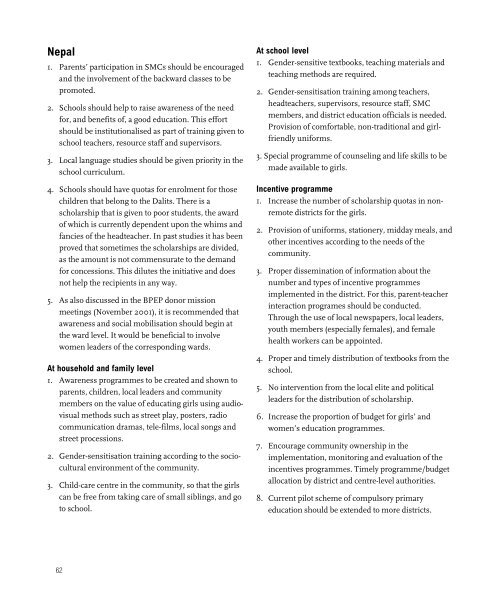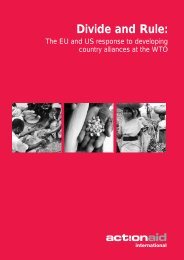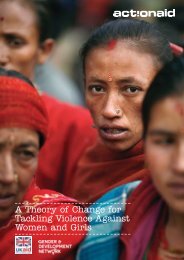A fair chance - United Nations Girls' Education Initiative
A fair chance - United Nations Girls' Education Initiative
A fair chance - United Nations Girls' Education Initiative
You also want an ePaper? Increase the reach of your titles
YUMPU automatically turns print PDFs into web optimized ePapers that Google loves.
Nepal1.Parents’ participation in SMCs should be encouragedand the involvement of the backward classes to bepromoted.2.Schools should help to raise awareness of the needfor, and benefits of, a good education. This effortshould be institutionalised as part of training given toschool teachers, resource staff and supervisors.3.Local language studies should be given priority in theschool curriculum.4.Schools should have quotas for enrolment for thosechildren that belong to the Dalits. There is ascholarship that is given to poor students, the awardof which is currently dependent upon the whims andfancies of the headteacher. In past studies it has beenproved that sometimes the scholarships are divided,as the amount is not commensurate to the demandfor concessions. This dilutes the initiative and doesnot help the recipients in any way.5.As also discussed in the BPEP donor missionmeetings (November 2001), it is recommended thatawareness and social mobilisation should begin atthe ward level. It would be beneficial to involvewomen leaders of the corresponding wards.At household and family level1.Awareness programmes to be created and shown toparents, children, local leaders and communitymembers on the value of educating girls using audiovisualmethods such as street play, posters, radiocommunication dramas, tele-films, local songs andstreet processions.2.Gender-sensitisation training according to the socioculturalenvironment of the community.3.Child-care centre in the community, so that the girlscan be free from taking care of small siblings, and goto school.At school level1.Gender-sensitive textbooks, teaching materials andteaching methods are required.2.Gender-sensitisation training among teachers,headteachers, supervisors, resource staff, SMCmembers, and district education officials is needed.Provision of comfortable, non-traditional and girlfriendlyuniforms.3. Special programme of counseling and life skills to bemade available to girls.Incentive programme1.Increase the number of scholarship quotas in nonremotedistricts for the girls.2.Provision of uniforms, stationery, midday meals, andother incentives according to the needs of thecommunity.3.Proper dissemination of information about thenumber and types of incentive programmesimplemented in the district. For this, parent-teacherinteraction programes should be conducted.Through the use of local newspapers, local leaders,youth members (especially females), and femalehealth workers can be appointed.4.Proper and timely distribution of textbooks from theschool.5.No intervention from the local elite and politicalleaders for the distribution of scholarship.6.Increase the proportion of budget for girls’ andwomen’s education programmes.7.Encourage community ownership in theimplementation, monitoring and evaluation of theincentives programmes. Timely programme/budgetallocation by district and centre-level authorities.8.Current pilot scheme of compulsory primaryeducation should be extended to more districts.62
















